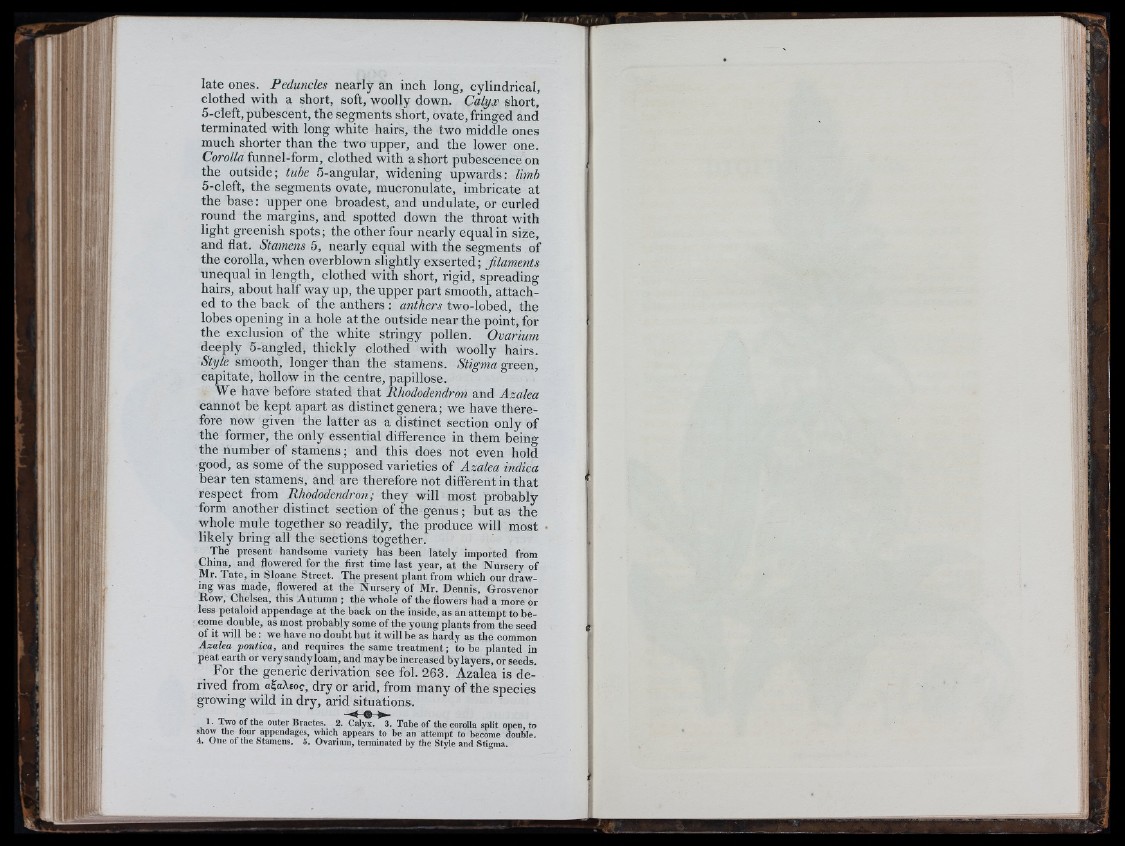
late ones. Peduncles nearly an inch long, cylindrical,
clothed with a short, soft, woolly down. Calyx short,
5-cleft, pubescent, the segments short, ovate, fringed and
terminated with long white hairs, the two middle ones
much shorter than the two upper, and the lower one.
Corolla funnel-form, clothed with a short pubescence on
the outside; tube 5-angular, widening upwards: limb
5-cleft, the segments ovate, mucronulate, imbricate at
the b a se : upper one broadest, and undulate, or curled
round the margins, and spotted down the throat with
light greenish spots; the other four nearly equal in size,
and flat. Stamens 5, nearly equal with the segments of
the corolla, when overblown slightly exserted; jilaments
unequal in length, clothed with short, rigid, spreading
hairs, about h alf way up, the upper part smooth, a ttached
to the back of the anthers : anthers two-lobed, the
lobes opening in a hole a tth e outside near the point, for
the exclusion of the white stringy pollen. Ovarium
deeply 5-angled, thickly clothed with woolly hairs.
Style smooth, longer than the stamens. Stigma green,
capitate, hollow in the centre, papillose.
We have before stated th a t Rhododendron and Azalea
cannot be kept apart as distinctgenera; we have therefore
now given the latter as a distinct section only of
the former, the only essential difference in them being
the number of stam en s; and this does not even hold
good, as some of the supposed varieties of Azalea indica
bear ten stamens, and are therefore not different in th a t
respect from Rhododendron; they will most probably
form another distinct section of the g en u s; but as the
whole mule together so readily, the produce will most
likely bring all the sections together.
The present handsome variety has been lately imported from
China, and flowered for the first time last year, at the Nursery of
Mr. Tate, in Sloane Street. The present plant from which our drawing
was made, flowered at the Nursery of Mr. Dennis, Grosvenor
Row, Chelsea, this Autumn ; the whole of the flowers had a more or
less petaloid appendage at the back on the inside, as an attempt to become
double, as most probably some of the young plants from the seed
of It will b e : we have no doubt but it will be as hardy as the common
Azalea pontica, and requires the same treatment; to be planted in
peat earth or very sandy loam, and maybe increased by layers, or seeds.
For the generic derivation see fol. 263. Azalea is derived
from agaXroc, dry or arid, from many of the species
growing wild in dry, arid situations.
1. Two o f the outer Bractes. 2 .~ c t l^ . Tube o f the corolla split open, to
show the four appendages, which appears to be an attempt to become double.
4. One o f the Stamens. 5. Ovarium, terminated by the Style and Stigma.